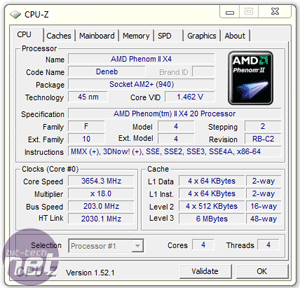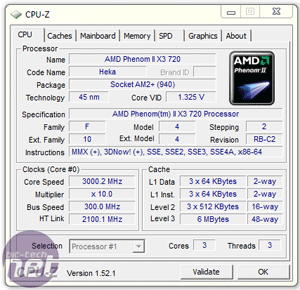Overclocking
Overclocking with core unlocking was excellent – we achieved an impressive 3.65GHz overclock with four cores enabled on our Phenom II X3 720 Black Edition CPU, although not being able to run a 2.6GHz CPU-NB clock was a bit disappointing. The previous 790FX-GD70 was the only board we’ve found able to run our X3 720 BE at that frequency, although the 2,436MHz of this board is hardly slow.Our final benchmark overclock consisted of a 203MHz HTT with an 18x CPU multiplier, 2,030MHz HT Link. This required a lot of overvolting: we set the CPU-VTT voltage at 1.4625V, CPU-NB at 1.3625V, CPU voltage at 1.47V, CPU-NB at 1.372V, CPU PLL at 2.572V, DRAM at 1.651V, NB voltage at 1.16V, HT Link and Southbridge voltage at 1.2V.
The maximum HTT overclock was limited to 300MHz however (with the standard three cores enabled). Despite taking all MSI’s advice, we could just about get this frequency stable with a much larger NB (by which MSI means ‘chipset’) voltage of 1.3V. MSI has shown us that a 366MHz HTT is achievable, but we could not replicate its result with our CPUs. The [eurl= http://www.bit-tech.net/hardware/motherboards/2010/03/02/asus-m4a89gtd-pro-usb-review/1 ]Asus M4A89GTO Pro/USB[/eurl] and Crosshair IV Formula are better overclockers for non-Black Edition CPUs that require loads of HTT overclocking
BIOS
The BIOS is very similar to the previous 790FX-GD70, with all the overclocking options held in the Cell Menu. There are independent frequency and multiplier adjustments for CPU, CPU-NB, memory and HyperTransport, and read-outs below each setting to show you what changes your tweaks are making. This is a massive help when overclocking.The core unlocking allows per-core control, so if you use a Phenom II X2 and one of the two hidden cores doesn't work, you still have a chance of ‘upgrading’ the CPU to a triple-core. However, MSI isn’t clear about the process of core unlocking, where you have to unlock the disabled cores, save and restart and then re-enter the BIOS to do any overclocking. If you unlock and overclock at the same time, the board will refuse to POST and recovers itself to the hardware default settings.
The memory timings worked fine and are plentiful like most AMD boards these days, although running CL6 seems to be still an issue. The voltage options are also numerous, with more than most of us will ever care to use. However, those looking at the extreme performance side again will probably enjoy the Reference and PHY voltages for the memory.
Voltages can be typed in directly - which is always useful - although this isn’t the case for the four CPU and CPU-NB values. This is annoying, as these are the menus we used the most when overclocking. MSI splits the CPU and CPU-NB into the normal core voltage and x-VDD version too - typically you'll want to hit the VDD first, then just push the core voltage underneath more gently after.
Other features include MSI's M-Flash, which worked when we used it on this board (even if we’ve had bad experiences with it in the past) and the slots to save overclocking profiles.
The Green Power hardware and its LEDs can be turned on or off in the appropriately named BIOS section, and we found the CPU fan control settings worked well, even if only basic 3-pin control was available on the other fan headers. MSI has now included DrMOS temperature readings in the Green Power menu, but in the recent BIOS update it removed the useful 890FX Northbridge temperature reading for reasons we have yet to extract - more aggressive torture techniques are clearly needed.

MSI MPG Velox 100R Chassis Review
October 14 2021 | 15:04




















Want to comment? Please log in.